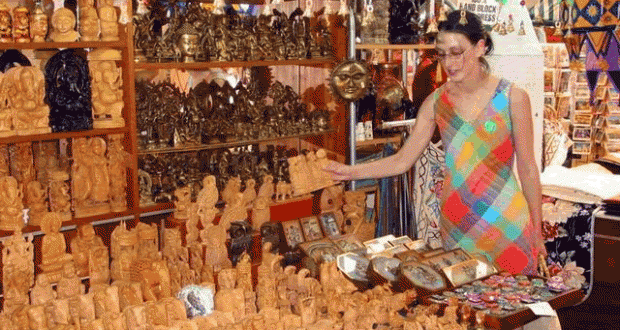India is one of the great markets of the world. You can find a remarkable range of fabulous produce—silk, cotton, leather, jewellery, carving and handicrafts—at real bargain prices, sometimes four or five times cheaper than abroad. The quality of craftsmanship can be excellent, and even if what you want is not in stock, it can invariably be made up for you—either done on the spot, or sent on later.
Tailors can run up clothes overnight, and although cuts tend to be a little out-moded for those with more fashionable tastes, they will copy any design you provide to perfection, and it’s worth bringing along a favourite piece of clothing for that very purpose. Bulky purchases, such as carpets and large ornaments, can be shipped home for you. Expensive jewellery buys can be verified for you atgem-testing laboratories. Large hotels have their own shopping emporia, packed with a wide variety of goods, where you can shop in air-conditioned comfort.
Always try to start your shopping tour with a visit to a government or state emporium. These stock the full range of local produce and handicrafts, sometimes also a selection of goods from neighbouring states. Because all prices are fixed, you are able to establish exactly what is available, and how much it should cost. This knowledge can be invaluable when it comes to buying things in less scrupulous high-street shops, markets or bazaars.
The best all-round places to shop are the huge Central Cottage Industries Emporia, currently located in Delhi, Bombay, Calcutta, Jaipur and Bangalore. These are the places you can do all your shopping in one place—very popular with people making last-minute purchases before flying back home. Of the smaller state emporia, make a point of visiting those of Gujarat and Rajasthan: these provide the most colourful, attractive and exotic variety of handmade goods.
On the streets, you’ll have to bargain hard when buying anything. The big thing to bear in mind is that there is an Indian price and a tourist price for everything. Never accept the first price given; it will always be too high. You can try the ‘walk away’ technique to bring it down, but many Indians have got wise to this, and you may end up walking away from something you really want, and never being called back. It is often far more effective to pretend interest in something you don’t want, haggle over it a bit, affect to lose interest, then pick up the article you do want almost as an afterthought. To make some sort of sale, the vendor will often give a half-decent price immediately. If he doesn’t, some well-chosen Hindi phrases will always improve your chances of getting the local price. Asking kitne poise? (how much), grumbling bahut paisa hai ! (too much) and wheedling Qum ka yo (come down a bit) often have the desired effect. It is also helpful to have aske d a local Indian the correct price of the item even before entering the shop.
Bargaining can be great fun. Once you’ve got the hang of it, it’s possible to buy things in markets and bazaars even cheaper than in fixed-price emporia. But beware, travellers do get carried away by success, and it’s not uncommon to meet someone stuck with £2000 worth of useless carpets, the result of being sweet-talked into visiting some street-tout’s ‘uncle’s shop’ or ‘brother’s silk emporium’. With big buys, you really do have to know what you’re talking about. Don’t let anyone take you anywhere you can’t afford to go. In any shopping situation, as soon as you’ve lost the initiative, you’re halfway to buying something you don’t even want. Even worse, you may have to lug it halfway round India until you find some way of sending it home.
Most decent shops and emporia a) give you a certificate of origin with major purchases and a receipt (essential for when the article hits customs; very expensive if you can’t produce them); b) arrange for the item(s) bought to be shipped home for you. In case a completely different article turns up at your front door, it can be a good idea to photograph or mark the item at the time of actually purchasing it.
Unless you have to, don’t make all purchases in one place. Different areas of India are famous for different things. You’ll always get a better choice and quality of when you buy at source, rather than from a central government emporium.
Go to Agra for sublime marble inlay work, to Jaipur for gems and jewellery, to Mvsore for incense and sandalwood, to Varanasi for silks and brasswork, toHyderabad for silver inlay and for pearls, to Udaipur for miniature paintings and for wall-hangings, and to Rajasthan in general for chunky folk-art jewellery, colourful mirror-embroidery and white-glazed pottery.
If you want to know more about these products, manufacturing processes, general prices, and how to tell the real McCoy from cheap tourist tat, read the appropriate shopping sections in the main body of the text. If this only whets your appetite, there are ample opportunities in many handicraft centres to visit local crafts factories and see carpets, miniature paintings, tapestries, carvings and even incense being made. There is no obligation to buy at these places—just a lot of friendly pressure.


